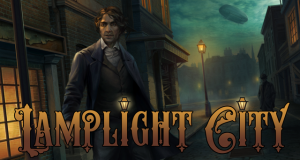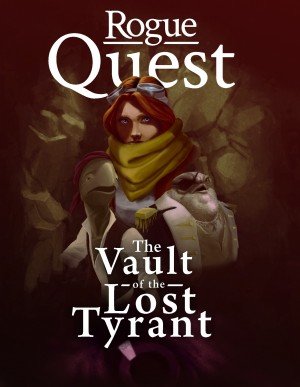Review for Lamplight City page 2
In recent years we’ve seen an ever-growing shift from adventures with straightforward, linear stories to ones that try more and more to incorporate a degree of player choice. Pitched as “a detective game where it’s okay to fail,” the 2D point-and-click Lamplight City by Grundislav Games sounds like another step in this direction. Set against an atmospheric, stylishly drawn, and narratively interesting backdrop, I was keen to see how the mysteries and decision-making would play out in a game with such high production values. The result fell a bit shy of what I was expecting, since most of the time there is no choice other than to passively click through the many extended dialogs.
Lamplight City is set in the 1800s of New Bretagne, a pseudo-New Orleans of an alternate Earth history where the use of steampunk technology is on the rise. You play Miles Fordham, a disciplined and capable detective for the city’s police department during the game’s playable prologue. Your partner is Bill Leger, who is rather less disciplined and injects comments that range from small smile-inducers to downright groaners.
The two detectives have been summoned to a flower shop. Someone has been breaking in after hours and stealing flowers but leaving money behind to cover the cost. Miles and Bill are there to search the store and track down the culprit. Minor spoiler alert: the investigation does not go to plan and Bill ends up dead. Fast forward three months to the story proper: Miles is no longer on the police force and takes a nightly soporific that dulls his wits but is needed to drown out the voice of the spirit of the deceased Bill, who is haunting Miles and demanding that he track down his killer.
With Bill speaking constantly in his head, Miles is a bit worse for wear at this point. Even so, he still has some friends in the police department who want to help get him back on his feet. Chief among these is Constance Upton, the office secretary who is responsible for dispatching bulletins to the field officers. Recently a high society lady was pronounced dead, only to awaken and start banging on her coffin in the middle of her funeral. While the police have a suspect in custody, Upton believes it’s the wrong person. She meets Miles at the local coffee shop to convince him to look into the case, the first of five that Miles and Bill experience throughout the game.
Between cases, Miles usually goes home to have a chat with Bill – or it’s more appropriate to say Bill has a chat with Miles, as Miles just wants Bill to be quiet. During these interludes, Bill is rather one-track-minded, demanding that former partner stop sedating himself and get on with finding the killer. Bill’s intrusions into the protagonist’s thoughts help you sympathize more with what Miles has been going through, although the conflict between the two men never really comes to a head at any point. Things get even more complicated for Miles because he’s been keeping Bill’s otherworldly existence secret from his wife Addie, putting even more strain on their relationship. It’s an interesting thread although not the main focus of the story, which is squarely on the different mysteries presented.
During each case you’ll travel to a wide variety of locations, with more being added in later investigations. Each place of interest typically consists of one or two scenes, with other areas accessible via a map of the city. There is quite an impressive array of locales, from the opulent houses of society’s upper crust to the oppressive streets of Cholmondeley (pronounced Chumley), one of the lower class neighbourhoods, so you’ll get to see the city’s many socio-economic strata. It’s not all homes and offices, however, as you’ll also stop by manufacturing plants, the cemetery, a bridge construction site, and a church, among other assorted destinations.
Every location is impressively detailed in retro-styled pixel art. Homes have intricate carpets and fancy wallpapering, while exterior locations give glimpses of the cityscape in the background. These scenes aren’t just pleasing to look at; they’re well designed and laid out in such a way as to draw the eye to the important hotspots in each one. Just to be sure, the mouse pointer changes when over an area that Miles can comment on or interact with.
Characters are also nicely rendered, ranging in attire from shabby to splendid as befits each person’s social station. Their movements are fluid and it’s nice to see that attention was paid even to having Miles open doors to walk through them rather than the common technique of cheaply fading to black. Of course, it’s not all about doors, as Miles will fish around in storm drains for evidence, climb through windows, and even get into a brief bout of fisticuffs (don’t worry, it’s just a cutscene, no action sequences here).
Music also adds to the atmosphere of Lamplight City, sounding suitably olde-worlde classical with hints of steampunk influences thrown in. The instrumental score never dominates nor distracts, but it does help to heighten the mood in any given scene. The sense of place is completed with appropriate sound effects, whether it’s the soft tread of Miles’s footsteps, the murmur of distant crowds outside, or the hiss of various steam tech devices.
While there are a lot of places to visit, the focus is on meeting with all the different people that inhabit them. There are quite a few characters encountered here and they’re all voiced to quite a high standard, although the same actors have been reused a number of times, which is most noticeable for a handful of female roles. Even so, the actors deliver solid performances – which is good, because they’ve got so much to say.
The bulk of the game’s twelve hours of play time is spent talking to people. This is mostly done through lengthy dialog trees modeled on the ones used in Gabriel Knight: Sins of the Fathers. During these conversations, animated portraits of Miles and whoever he’s talking to are displayed against a black background, with a list of topics shown between them. Each character is beautifully detailed and has been fully lip-synched with their lines of dialog. It’s an impressive amount of effort, and crucial given that these exchanges are what you’ll spend almost all of your time doing.
Unfortunately, it’s during these interviews that the game hits a snag due to their sheer volume. It’s quite common to have at least seven or eight different topics to grind through, with each individual subject tending to go on at some length. The goal is to find the topics that reveal leads to other characters to talk to next. However, as there’s no real way to gauge which line of questioning might result in such leads, the default approach for most people will be to simply go through all the trees picking each option in turn. It’s the dialog equivalent of trying everything on everything, with the effect of feeling more like you’re watching an extended cutscene that you periodically have to unpause. No matter how detailed the portraits, you are, at the end of the day, left looking at nothing more than two talking heads. It makes for a very passive playing experience, even by adventure game standards.
Occasionally during your investigations, you do get to break away from just going through another dialog tree. Sometimes you’ll get to examine a crime scene, which requires finding key hotspots. Other times you’ll get to do more immediately interactive tasks, like figuring out how to open a locked window from outside, or analyzing different chemical compositions in the police lab. Nowhere will you find yourself selecting items for use, as Lamplight City doesn’t have an inventory. Every now and then Miles will be able to pick something up, but he will always use it automatically in the correct place when appropriate. None of the special hands-on activities are all that tricky or complex, but at least they have the novelty of giving you something to actually do. There are only a few of them sprinkled throughout, and more would have been quite welcome to help break up all the talking.
During any given investigation, you will typically uncover multiple suspects that could be accused of the crime. Once you’ve found at least one such suspect, you can go back to whoever asked you to look into a case – usually Constance – to solve it. Here is where Lamplight City lives up to its billing of allowing you to fail, as the actual solutions for the most part aren’t nearly as simple as they first appear. You’ll need to make sure to keep digging, which essentially means talking to everyone until you run out of topics to discuss in order to discover all possible culprits. It’s then up to you to choose which one to accuse. Don’t worry about accidentally getting a case wrong, though. If you’ve fully investigated everything, it’s always clearly spelled out who the real criminal is.
You can be a jackass if you want and throw someone else under the metaphorical hansom cab if you so choose, but even then, the consequences of getting a case wrong aren’t as significant as one would expect. Mostly it amounts to a different write-up in the next day’s newspaper, though in some instances if you accuse the wrong person, certain lines of inquiry will not be open to you in subsequent cases, possibly even denying you access to key potential suspects.
There are also a few times when you can insult someone in conversation if you say the wrong thing. You are usually given a warning when you get to one of these junctures, and the choices themselves are presented as dialog options at the bottom of the screen instead of the typical topics of discussion located in the center of the screen. As with accusing the wrong person, if you offend somebody they’ll refuse to talk to you, not just in the current case but during subsequent investigations as well.
In theory, the ability to fail should offer some replayability, but in practice it’s not as simple as that here. Getting a suspect wrong or insulting somebody simply closes off parts of the game without providing any alternative path to go through. In essence, you end up playing an abbreviated version of the game. If you go into Lamplight City looking to play it multiple times, I’d suggest insulting everyone you can and choosing to accuse the wrong person in every case first time around. That way, on a subsequent replay you’ll at least have access to more content that you were denied the first time.
The cases themselves offer a good deal of variety, including murder, kidnapping, and even a serial killer. Given that multiple suspects are available in most cases, there are usually one or two twists that make the mysteries less obvious. While uncovering these, you’ll also discover quite a bit about the narratively rich world around you. You’ll learn about the politics, technology, spirituality, class-based discrimination, and assorted other social issues that help to make this fictional environment seem real. There’s a lot of worldbuilding on display here, and acting as an investigator allows you to see these aspects from a variety of different perspectives.
To help keep track of your cases, the game offers a built-in journal, accessible from a menu bar that appears when you move your mouse to the top of the screen. The journal keeps track of leads you still have to follow up on (essentially a “to do” list), suspects that you’ve amassed for possible accusation, and assorted clues and documents you’ve found along the way. It’s a nice touch, as it allows you to walk away from the game for a while and then review where you were at when you come back later.
Lamplight City has a lot going for it. It has beautiful backgrounds and fluid animations, with solid audio complementing the pixel art presentation. It also has a lot of fleshed-out worldbuilding and background information to uncover along the way. It’s a shame, then, that all this is rather tempered by the fact that the majority of gameplay consists of moving from one person to another and grinding through all of the conversation topics available. While the writing is by no means bad, there’s just so much of it, with nothing for players to do but look and listen and periodically click to advance the dialog. Sadly, this doesn’t lead to more complex mysteries with equally plausible theories in which failure is a legitimate option; instead it’s just a largely insignificant consequence of skipping through the many interrogations. Without much in the way of puzzles to pose a challenge, your enjoyment of this adventure will be directly related to how much you like listening to dialog. Love a good chinwag? This is the game for you. If not, move right along as you won’t find what you’re looking for here.
WHERE CAN I DOWNLOAD Lamplight City
Lamplight City is available at:
- GOG -40%
- HumbleBundle































